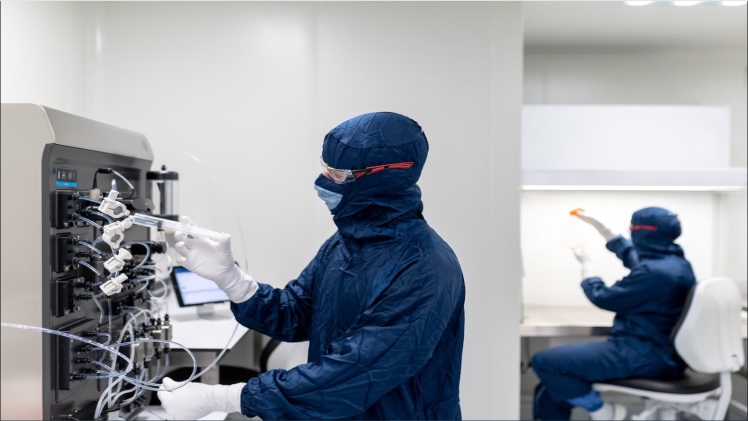The challenge of keeping cleanrooms sanitary and meeting regulatory standards is enormous. In this case, it’s safe to assume that all objects, both within and outside the room, could be a source of infection.
Every company making products for use in the medical or electronic field uses cleanrooms. Because even the tiniest airborne particles can have catastrophic effects, requiring costly downtime and cleanup operations in industries as diverse as pharmaceutical production, high-tech semiconductor fabrication, and biological specimen study.
This contributes to the growing size of the cleanroom market, as it is projected to become worth $5,828,7 billion by 2027.
Cleanroom Classifications
We might not realize it, but we carry a lot of bacteria on our bodies and clothes, which can cause a catastrophe. Cleanrooms have different classifications, and they are used in the lab according to the nature of the requirement. They are categorized based on the maximum permissible particle concentration in a given air volume.
Class 1000 cleanroom classifications allow 1000 particles/cubic foot. Similarly, Class 100 cleanrooms allow 100 particles/cubic foot. Upholding stringent cleanliness standards in cleanroom environments is a herculean task.
Everything in the workplace, from tools to airflow, must be monitored and controlled to ensure the cleanest possible environment for the workers. The entire space, as well as anything brought into it, is a potential germ incubator.
Staff members are the primary source of contamination in cleanrooms, as reported by the National Environmental Balancing Bureau (NEBB). Nearly 70% to 80% of cleanroom contamination issues can be traced back to operators and technicians.
To a lesser extent, the following four factors also contribute to contamination by cleanroom personnel and/or operators:
Hygiene
In a tightly controlled setting, even slight differences in personal cleanliness can significantly impact the likelihood of contamination. Potentially harmful particles, such as dandruff, hair, and loose skin, might leak out from under protective garments if a person’s hands and face are not well cleaned.
Instructions on proper hygiene are of utmost importance. Facial and hand hygiene is paramount, so remove any extra lotions or makeup before proceeding.
Particular attention should be paid to the cuffs and ankles of cleanroom gear, as particles might escape through these areas if they aren’t properly covered. Operators should also wear full cleanroom suits to avoid introducing contaminants through sweat, skin flakes, and other bodily fluids.
Undergarments
More thought should be given to the street clothes worn under cleanroom apparel. To prevent contamination from everyday clothing, cleanroom workers must wear specific clothing designed for the environment.
Even while operators should wear special protective garments, they can further limit the likelihood of contamination by paying attention to the types of clothes they select to wear to work.
Fabrics prone to shedding or developing “pills,” such as flannel, suede, velour, and others, pose an additional threat to the natural world. There can be no contamination from these materials escaping from cleanroom apparel if they are not there, to begin with.
Stale Smoke
When someone smokes a cigarette or cigar, they exhale particles that remain in their lungs and are slowly released into the air. This is called “residual smoke,” and it’s different from secondhand smoke. This is a big challenge in keeping cleanrooms sanitized.
According to a report by Statista, over 200 billion cigarettes were sold in the US in 2020 alone. That makes it difficult to avoid smoke, even for a non-smoker. It is a big challenge in keeping cleanrooms sanitized.
Cleanrooms are vulnerable to contamination by smokers, even if they don’t light up while on the clock. Gargling or rinsing the mouth is a simple way to help smokers reduce this risk.
However, the most effective option is to have everyone wear facemasks, which will keep the confined space free of any lingering smoke and other particles in the air.
Operator Attitude
The mentality of technicians and operators with regard to the possibility of producing contamination at some time is not a physical issue but is nonetheless crucial. It’s more probable that anything will go wrong because an employee who doesn’t know or care why they need to follow a given method will fail to follow that procedure.
Staff morale and disposition should be closely observed. Everyone needs to pitch in to maintain quality. Reminding everyone to do their part and offering suggestions for making processes more efficient frequently is important.
Cleanrooms are not just used for manufacturing medicine, food, and things of this nature. The famous Mars rover that went into space in the year 2020 was also made in a cleanroom by NASA.
While it’s true that donning a gown for the cleanroom takes some time out of your day, remember that the cleanroom is an expensive investment that must be protected at all costs. It is imperative for both the product being made and the cleanroom itself.
